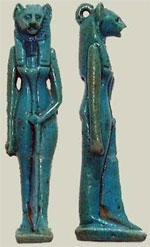return to Home Page
or move on to Goddess Uke-Mochi-No-Kami, next chronologically,
or use Her Cyclopedia Index
Ubasti, She-of-the-City-Bast.
WB*STE
Alternate meanings: {She-Who-Brings-Forth}.
[to Whom the twenty-fifth day of February, day 055, is dedicated]
